Italian Art in the 1920s and 1970s: Affinities and Differences
Renato Barilli Renato Barilli Metaphysical Masterpieces 1916–1920: Morandi, Sironi, and Carrà, Issue 4, July 2020https://italianmodernart-new.kudos.nyc/journal/issues/metaphysical-masterpieces-1916-1920-morandi-sironi-and-carra/
This paper establishes some affinities between the creations of the 1920s (i.e. including Metapysical painting, Novecento, “rappel á l’ordre,” etc.) and those produced nearly sixty years after, in the 1970s. As is well known, artists of the 1920s – and especially the protagonists of Futurism (i.e. Carlo Carrà, Luigi Russolo, Mario Sironi, etc.), the decade’s most advanced avant-garde movement – primarily concerned themselves with a process of abandonment, of inverting their attention from the present in order to retrieve the past and recuperate the masterpieces found in museums. This retrospective impulse resulted from the influence of Giorgio de Chirico who, wholly confident in proceeding down his own artistic path, wished to conceive “originary” solutions (i.e., connected to the origins), rather than “original” ones. The same creative impetus laid at the foundation of Arte Povera, a movement established decades later whose founder, Germano Celant, in fact, was tempted to declare the movement a “New” Futurism. From this very advanced group there emerged yet another contrary spirit, represented in the work of Giulio Paolini, Luciano Fabro, and especially the young Salvo. Unlike those associated with Arte Povera, this last artist refused to condemn color and opted instead to introduce an exceptionally brilliant “palette,” that brought to mind colored images on TV and, especially, the naive world of cartoons. Almost immediately after Salvo, Luigi Ontani embarked on this same path: his colored photographs seemed dedicated to resurrecting the historical (or folkloric) figures contained in museums. Later another rich group of artists naturally emerged, to which I myself gave the name of Nuovi-Nuovi, built on the innovations of these two pioneers; however, almost simultaneously, another group (including Carlo Maria Mariani and Stefano Di Stasio) embraced the label of “anachronism” wherein the prefix “ana” proclaims going “á rebours” through the stream of time. Finally, in such a propitious situation, a third group was born: the Transavantguard (including Sandro Chia, Francesco Clemente, Enzo Cucchi, and Mimmo Paladino). Here again the prefix “trans” proclaims the artists’ refusal to respect the normal trend of time. All these very stimulating groups considered themselves to be under the protection of an eternally “revenant” de Chirico, who, while continuing his very coherent search of mythical origins, was ready to accept newer times, consisting in a spirit of lightness, of enchanted colorism, of irony, and of all aspects that would ultimately come to be considered deeply intrinsic to so-called postmodernism.
In my long career as an art historian, I have frequently turned to the contributions of an illustrious predecessor of mine, Heinrich Wölfflin, Swiss by birth but a German university professor.1 He has remained famous for his theory regarding the manner in which dialectical opposites follow each other in succession over the years. He considered four pairs: open-closed, light-dark, paratactic-hypotactic, and linear-pictorial. All are without doubt connected to one another, but the most important pair is the first – open-closed – for the immediate obviousness of the two terms. He considered these categories as the extremes of a pendulum swing, in the sense that artistic phenomena move along an axis from the first position towards the opposite, but having once reached this sort of terminus, they can go no further, just as occurs with a pendulum, and so must begin the opposite return motion, towards the other extreme. Wölfflin particularly applied this concept to two classic moments in the history of Western art – the Renaissance and the Baroque – which all evidence confirms followed this pendular rhythm. However, nothing prevents us from extrapolating the notion from that context and applying it to many other historical periods, both past and future.
Yet, an objection immediately presents itself: if we passively accept this criterion of oscillations, we risk remaining immobilized in a forward-backward movement that continually takes place on the same plane, as indeed happens with a pendulum. But as a true historian, Wölfflin was extremely keen to also include in his concept the dimension of time, of becoming. And so, in this way, the oscillatory motion of the pendulum, in combination with the rectilinear axis of historical becoming, results in a spiral-shaped graph. That is to say that art, like any other cultural phenomenon, periodically retreats to an earlier-held position, but with an added degree of innovation, given that this new passage occurs at another level. In other words, the repetition of certain previously held situations occurs as a sort of overflight. Apropos of this, I adopted the title of a book by French philosopher Gilles Deleuze to forge the expression “different repetition.”2 If a simpler analogy makes things clearer, think of what happens at a car or motorbike racing circuit when the leader may at times appear to be behind the last, therefore one has to keep count of the laps completed to understand the true positions of the contenders.
Let us now apply this model to what happened in the art of the Western avant-garde during the first two decades of the last century, where “open” was undoubtedly the dominant category. Consider two major movements, Cubism and Futurism, which “opened” the borders, the mass of human figures and objects, to give them an extension in space through processes of vigorous disassembly, the clearly visible route taken by Pablo Picasso and Georges Braque, Umberto Boccioni and his colleagues. However, we can also identify an artist dedicated to a completely personal route, who deliberately resisted the invitation to openness, and instead barricaded himself inside a cautious closure, essentially making a profession of passatism rather than Futurism. I am obviously referring to Giorgio de Chirico, who even theorized his own completely unique option by rejecting any commitment to being “original,” or a follower of the new at any cost, as artists at that time claimed to be (figure 1). Instead he sought to connect with the origins of art by essentially revisiting the museum of earlier acquired forms.3 For quite a few years, de Chirico remained alone in following his counter-current decision, but towards the middle of the 1920s, he was joined by other artists, and precisely because of the effect of the pendulum swing Wölfflin had posited for earlier periods. In other words, the Cubists and the Futurists realized they had reached a ne plus ultra in the breaking down of forms, and therefore it was time to reverse gear, to reassemble, to return to within recognizable boundaries.
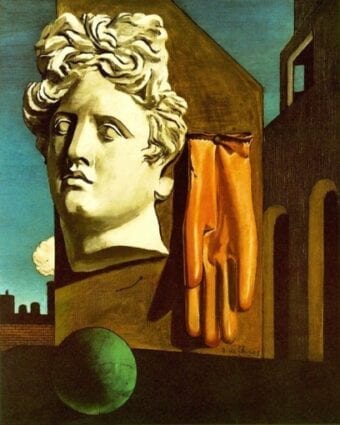
This was a phenomenon that affected almost all the experimenters of those years, first and foremost Gino Severini, whose work perhaps should have been included in the exhibition at CIMA that was the occasion for this essay. In 1916, when Severini was living in Paris, he gave us a completely traditional Maternità (Maternity, 1916; figure 2), eradicating the “ragged,” splintered style he had adopted until then, even though he did not intend to relinquish it entirely. Perhaps André Derain, a French fellow artist, had already preceded him on that road. The same thing almost simultaneously occurred with members of the Milan group of Futurists, Carlo Carrà and Luigi Russolo, who had actually acted the most violently in the explosion of forms. Perhaps the Futurist leader Boccioni himself was pondering a similar path when death stopped him en route, in 1916.

Meanwhile, the horrendous First World War had broken out, heralding many tragic outcomes, including among the ranks of the avant-garde. De Chirico took refuge in a military hospital in Ferrara to avoid the front, and for more or less the same reasons Carrà was also there. Carrà had already embarked on his own courageous return path, going back so far as to offer us images in a primitive, barbaric style. At the same moment, again in Ferrara, the epitome of a similar reverse-gear phenomenon emerged, known by the name of “Metafisica,” whose fascination was also felt in nearby Bologna and characterized Giorgio Morandi’s first moves. But the attraction of “full speed astern” was indeed very strong at that time; almost no one knew how to resist it.
If we return to Paris, this reverse motion was also embraced by the number one of experimentation, Picasso, who gave us wonderful works in this retro direction, in the form of a rediscovered heavy three-dimensionality, swollen and affected by elephantiasis. Moreover, this swing towards the “closed” pole was certainly not limited to the 1910s, but expanded to invade and occupy the entire 1920s as well. Metafisica gave birth to the journal Valori Plastici, in which the key figures of the Ferrara Metaphysical adventure appeared, immediately joined by Mario Broglio and his wife, Edita Broglio (née Walterowna von Zur Muehlen). At that moment, there was the emergency of an intelligent, politically active journalist who became a supporter of the young Mussolini: Margherita Sarfatti. She promoted the kindred “Novecento Italiano” movement dominated by Mario Sironi, another veteran of “open” Futurism. A similar climate to that evident in Italy can be traced in equal measure to Germany, where it found its theoretician in the refined figure of Franz Roh and his “Magischer Realismus” (Magic Realism), together with Franz Radziwill, Georg Shrimpf, and others, all arm in arm with the Italian exponents of Metaphysical art and the Novecento Italiano group. There was also another branch, which despite emphasizing realism, remained more faithful to the origins of Ernst Ludwig Kirchner and company’s “barbaric” Expressionism, namely the triad composed of Otto Dix, George Grosz, and Max Beckmann.
But my task is not to pursue the full span of “closed” experiences that occurred during the first decades of the last century. My task is to corroborate the repetition of Wölfflin’s graph through the reappearance, about half a century later, of that same pendular motion swinging once again from open to closed, but with all the “differences” imposed by the variant of the spiral, whereby the same waters are never returned to but are revisited at a different level, which inevitably introduces a degree of variation.
To begin with, the nature of the “open” had radically changed. We must retrace our steps to the climate of 1968, where it was no longer a matter of disassembling forms and three-dimensional constructions, but of questioning the classic tools: brush and palette. In accordance with technological changes, it was essential to welcome the “open” to a greater and more concrete extent: to make artworks invade the environment, to increase their tactile consistency, to solicit the entire range of our senses more directly, even to the point of invading the territories of the mind. The notion of “cold” was brought on board, as conceived by Marshall McLuhan, the most able theorist in diagnosing change in that era.4 We can define an era as “cold” when it engages all of our senses at the same time: not only sight, but also touch, walking, and corporality in general, with no longer any need for the accommodating mediation of paper or canvas. Consider the forest of movements that emerged in that climate: Minimalism, Land Art, Body Art, and Conceptual Art.
But, once again, the pendulum swung. In other words, as a result of “opening,” extending, and diluting, all these experimental paths suddenly discovered they had exhausted their energy, and so it was inevitable to find them sketching out a movement of grand return. This was facilitated by the presence of de Chirico, tenaciously clinging on to sound his rallying cry for a return to origins. I pride myself on having proposed a historiographic hypothesis about him that interprets all the steps he took in his constant and insistent proposal of returning to origins.
During the Metaphysical period, these origins had been found in the favorite museum rooms of our day: Greek archaism and its rebirth in the proto-Renaissance of Filippo Brunelleschi and Leon Battista Alberti. All of these were revisited as if in a dream, which provided the index of difference that must always be inserted to redeem the repetition of classic forms. Implacable, de Chirico then went off to visit the “bad” rooms, namely those that house the styles our current taste has condemned: an overinflated, emphatic baroque and a naturalism all too faithful to reality. But eventually, at the end of this journey, de Chirico rediscovered the room that now holds like sacred memorabilia his own paintings from the period considered as “good”: the masterpieces of Metaphysical art. Yet for him, too, the fundamental obligation to refrain from passively “repeating” them applied: new values had to be included. And for someone like him, a contented consumer of television programs, these qualities could come from TV.5 Let us not forget that in the early 1970s television had appropriated color, produced by a myriad of pixels, a feast of soft, suggestive colors that bordered on bad taste or kitsch: saffron yellow, pistachio green, and strawberry pink. De Chirico “repeated” his masterpieces from the Metaphysical period by pouring this enchanted palette over them, which, by the way, is the same one adopted by Postmodernism in its most accredited version, the one we find used by our Italian architects and designers – Aldo Rossi, Ettore Sottsass Jr., and Alessandro Mendini.6
The 1968 art scene in Italy found a kind of compendium in the so-called Arte Povera movement, theorized by Germano Celant. Its members cultivated all the “isms” of the period, all the ways of practicing “open” according to McLuhan’s description of “cold.” The parallel is evident between this innovative situation and Futurism, Italy’s most avant-garde “ism” of half a century earlier. In fact, Celant himself is said to have been in doubt as to whether to adopt the label “New Futurism” for his creature, except, of course, for the inevitable transition from heat to cold. And so it will come as no surprise to discover among the ranks of Arte Povera several artists who at a certain point felt they had reached the limit beyond which it was impossible to go. There were no more borders to “open” still further, to disseminate more remotely in space, and so all one could do was reverse the pendulum. The first among the Arte Povera artists to reason this way was Giulio Paolini, who consequently, and very coherently, concentrated on revisiting masterpieces from the past – by Raphael, Nicolas Poussin, or Jean-Auguste-Dominique Ingres – with worthy and acclaimed results (figures 3–4). But as a son of the 1968 revolution, he was naturally committed to the total negation of the picturesque. So Paolini’s works were, and still are, generally committed to a rigorous black and white, and a typical, clear, unembellished design, even though they do not disdain their place in space as three-dimensional sculptures, ones that resemble, however, the bad plaster copies used for educational purposes in fine art academies. In short, Paolini undeniably followed in the footsteps of de Chirico, yet reinterpreted him in “cold” terms, reducing the showiness of the pictorial elements in favor of more impalpable and elusive conceptual elements.
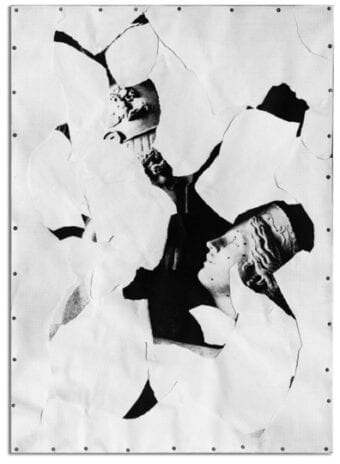
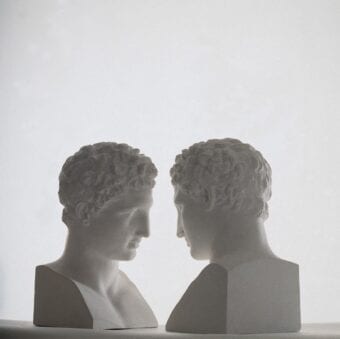
In the Turin group there was a young artist from Sicily named Salvo Mangione, who soon dropped his surname, introducing himself by his first name alone. He also accepted the 1968 code prohibiting the use of “hot,” sensuous approaches, favoring instead the cold and impersonal language of photography. In fact, Salvo initially offered us photographs of conventional figures linked to folklore – a hunter, a mobster – to which he promptly applied a quota of “difference” by replacing their faces with his own, in an act of manifest narcissism. Later he seemed to take the “conceptual” path by eliminating images and using only words, albeit plunging them into the sacred aura of monumental epigraphs. This was in imitation of a lesson from de Chirico, who always enjoyed inserting certain pompous phrases into his paintings, such as the self-declared pictor optimus. Salvo also proposed high-sounding phrases, such as Io sono il migliore (I am the best), taking care to carve them into a noble material such as marble (figure 5). It was a counter-tendency, since “conceptual” art at the time sought to display phrases of extreme banality. Salvo soon found the courage to overcome also the ban on color: he adopted it in bold, intense ways, in competition with the effects of color television. Furthermore, he took the accompanying step of using images, also returning to the museum for certain visions of saints and angels, reworked in the deliberately naive colors of a child repopulating the world of icons. From that moment on, Salvo became a virtuoso of landscapes filled with mountains, skies, clouds, and trees crowned in foliage, inspired by an enchanted repertoire, almost in competition with Disneyland – which is not afraid to sink into the horror of bad taste.
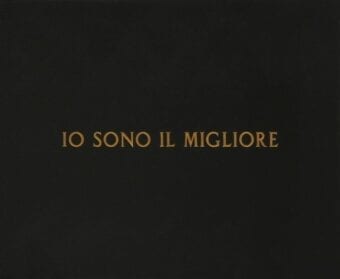
Very soon he was joined by another artist, Luigi Ontani, who had trained within a kind of offshoot that Arte Povera had developed in Bologna around Vasco Bendini and Pier Paolo Calzolari. Initially, Ontani too avoided painting, preferring photography, which he also employed to resurrect the masterpieces of the past; like Salvo, he inflicted upon them the invariable substitution of his own face for the original ones. Moreover, he soon found the courage to use color, mainly in the form of a light, transparent watercolor, deliberately keeping his “icon retrieval” on a level suspended between the physical and the mental. Unlike Salvo, however, who has always and only used two-dimensional forms, Ontani did not fail to heavily invade the third dimension, giving substance to his idols with the vulgar papier-mâché of allegorical carnival floats, or with clay, at once noble and popular (figure 6). Neither did he refrain from attacking space with his own body in performances: not naked, as the canons of Body Art would have preferred, but in an “ornate” style, flaunting clothes in the manner of ghosts from the past or exoticism.
If I stop for a moment now to reflect on my reactions, I can claim that I have always been timely in spotting new trends. At the invitation of Francesco Arcangeli, I was able to present at the 1972 Venice Biennale some representatives of “Comportamento,” the leading phenomenon in 1968.7 Two distinguished Arte Povera artists, Mario Merz and Luciano Fabro, went to the Venice Biennale for the first time at my suggestion; but, as usual, I did not limit myself to drawing from a single movement, and indeed on that occasion the invitation was also addressed to other worthy artists of the day: Franco Vaccari, Gino De Dominicis, and Germano Olivotto. Just two years later, I became convinced that the moment of pendular inversion had arrived. Therefore, I proposed an exhibition to the Marconi Studio in Milan in 1974 that would be dedicated to Ripetizione differente (different repetition),8 the phrase that presided over the completion of such a movement. There was the case of Paolini, together with other champions who were retracing their footsteps, but above all there were Salvo and Ontani, the only ones among the young artists who had already satisfactorily undertaken that great return.
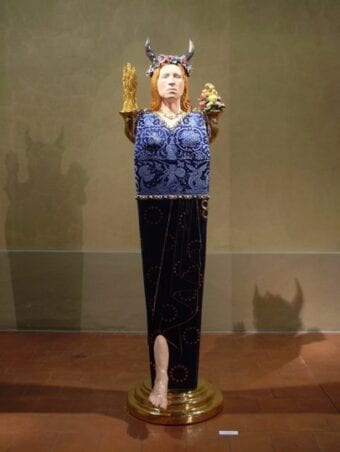
Many other similar cases followed, in a concentration that closely resembled what had occurred in the 1920s, when, as I mentioned above, the solitude of the Metaphysical duo de Chirico-Carrà had been succeeded by the various twentieth-century phenomena concerning the “call to order.” If, at first, the Salvo-Ontani duo seemed as though condemned to solitude, Carlo Maria Mariani soon took the stage in the role of a devoted copyist of museum masterpieces, ones selected this time from among the less popular subjects of our day and immersed in the worst kind of academic spirit. But the main difference compared with any other banal museum copyist was the fact that Mariani drew on nonexistent works. Maurizio Calvesi and others coined the perfect label for this attitude – “anachronism” – which precisely indicated this desire to go backwards – “ana” – with respect to the normal course of time. Many other similar cases gathered around him, while soon the Salvo-Ontani duo also had a good crowd of followers. Worth mentioning among these are Luigi Mainolfi (figure 7), Aldo Spoldi, Bruno Benuzzi, Marcello Jori, Felice Levini, Giuseppe Salvatori, and others besides. At the end of that decade, I gathered them under what I admit was the somewhat insipid banner of the “Nuovi-nuovi” (New-New). There was even the opportunity to accompany them to the prestigious gallery in New York managed by Holly Solomon, who marched in step with us, as I will shortly explain.9
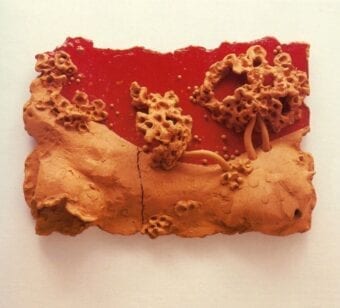
Generally speaking, I believe that in that decade, the 1970s, the legitimate primacy of Italian art was renewed and recognized. We had been the best in the 1920s, the most successful example in responding to the revolutionary “call to order,” namely the reverse swing of the pendulum towards “closed” and similar values, perhaps due to the power of the immense depository of our past. And yet again, half a century later, in the 1970s, this excellence on a global scale was reconfirmed precisely due to the large number of exponents that can be counted. In both cases, the 1920s and 1970s, the only nation that could compete with us was Germany, home of the aforementioned phenomenon that Roh had opportunely baptized Magischer Realismus while at the same time acknowledging the numerous affinities it had with what had taken place in Italy. Yet alongside Magic Realism in Germany, there was also and above all a revival of Expressionism, accomplished by the extraordinary trio mentioned earlier, of Grosz, Dix, and Beckmann. Their regurgitation of violence had no equivalent in Italy during that decade, but if we fast forward to the 1970s, the German version found a clear reply in the Italian Transavanguardia movement.
So far I have remained silent on this front, and I might be accused by some of guilty or biased reticence, given that I was the champion of the opposite trends, the New-New and the Anachronists – in other words, the tradition linked to the precedents of Metaphysical art and other related movements. The fact is, instead of cultivating a dream of retrospective elegance, a cult of the past, the members of the Transavanguardia marched in step with the Brutalism of the German Neuen Wilden: Georg Baselitz, Anselm Kiefer, and companions. This applies to the work of Sandro Chia, Francesco Clemente, Aldo Cucchi, and Mimmo Paladino.10 However, on closer examination, all of this confirms the thesis of my discourse, which rests on two cornerstones: the affinity between the two decades, the 1920s and the 1970s, and the fact that Italian and German art was preeminent. Neither France nor England – traditionally two nations of great influence – had been able to unsettle their European competitors in either of those historical moments.
However, I should not forget that although this article arose out of an exhibition aimed at celebrating the excellence of Italian art in the 1920s, and its rebound in the 1970s, the exhibition itself was held in the U.S., in New York, and therefore it is fair to ask what happened in North America in the 1970s. I believe we have to recognize that North America had by then lost the traditional leadership it had assumed in the post-World War II period, and this is understandable. I would say that it is natural for this part of the planet to lead a “progressive” march when the pendulum swings towards “open.” If, on the other hand, we once again hear the call of the past and of history, it seems inevitable that ancient Europe will exercise its good offices.
Nonetheless, the Big Apple was certainly not an artistic desert in this period. This is easy to discern if, for a moment, we consider again the phenomenon of the New-New, which is so dear to me, and which from the very start was always divided into two aspects. The first and main one was the cultivation of icons retrieved from museums and revisited. The second can be described as aniconic, aimed at reclaiming the values of decoration, with exponents such as Luciano Bartolini, Carlo Bonfà, Vittorio D’Augusta, and others. I did not hide the issue, and, as a true phenomenologist of styles, proceeded to account for it. Whereas on the contrary, Achille Bonito Oliva, a supporter of the Transavanguardia, did not worry about it at all, and placed Nicola De Maria, an excellent compiler of aniconic fabrics, in the same group as the four exponents of a violent figurative style.
To its merit, the New York scene in the mid-1970s developed a refined, consistent, and noteworthy episode of decorative art known as the Pattern and Decoration (P&D) movement, championed by the Holly Solomon Gallery, at the time located in the heart of Midtown, at the corner of Fifth Avenue and 56th Street. Solomon brought together the major exponents of this trend: Bob Kushner, Ned Smyth, Nicholas Africano, and others. Out of this grew the parallelism between the group I sponsored and the North American one, with a mutual exchange of exhibitions. Indeed, Pattern and Decoration is the weightiest token that New York can place on the scales to balance the joint prevalence of 1970s Italian-German art. Other than that specific and fertile group climate, only a few individual and isolated artists of great talent can be named, but no context can be created for them – a very different situation from the one across the ocean. I’m thinking of undeniably significant figures like Jonathan Borofsky, Julian Schnabel, Robert Longo, and David Salle. It is true that after that period of impasse, the Big Apple scene promptly revived itself, putting into orbit Jeff Koons, Haim Steinbach, and Peter Halley; and, shortly after, giving birth to the lush vegetation of the “Writers,” whose points of attack were represented by Keith Haring and Jean-Michel Basquiat.
Bibliography
Barilli, Renato, ed. Comportamento. Biennale di Venezia 1972. Padiglione Italia. Cinisello Balsamo, Milan: Silvana Editoriale, 2017. Exhibition catalogue.
Barilli, Renato, ed. Dieci anni dopo. I Nuovi-nuovi. Grafis, Bologna 1980. Exhibition catalogue.
Barilli, Renato, ed. La ripetizione differente. Milan: Studio Marconi, 1974. Exhibition catalogue.
Barilli, Renato. Scienza della cultura e fenomenologia degli stili. Bologna: BUP, 2007. The English-language version is The Science of Culture and the Phenomenology of Styles. Translated by Corrado Federici. Toronto: McGill-Queen’s University Press, 2015.
Barilli, Renato. Tra prezenza e assenza. Milan: Bompiani, 1981. First published in 1974.
Barilli, Renato. Tutto sul postmoderno. Rimini: Guaraldi, 2013.
Barilli, Renato, Flavio Caroli, et al., eds. Anniottanta. Milan: Mazzotta, 1985. Exhibition catalogue.
Deleuze, Gilles. Difference and Repetition. Translated by Paul Patton. London: The Athlone Press, 1994.
How to cite
Renato Barilli, “Italian Art in the 1920s and 1970s: Affinities and Differences,” in Erica Bernardi, Antonio David Fiore, Caterina Caputo, and Carlotta Castellani (eds.), Metaphysical Masterpieces 1916–1920: Morandi, Sironi, and Carrà, monographic issue of Italian Modern Art, 4 (July 2020), accessed [insert date].
- See my Scienza della cultura e fenomenologia degli stili (Bologna: BUP, 2007). The English translation is The Science of Culture and the Phenomenology of Styles, trans. Corrado Federici (Toronto: McGill-Queen’s University Press, 2015).
- See Gilles Deleuze, Difference and Repetition, trans. Paul Patton (London: The Athlone Press, 1994).
- My reflections on de Chirico can be found in the dedicated chapter in Tra prezenza e assenza (Milan: Bompiani 1974, 1981).
- See my chapter on McLuhan in ibid.
- In this regard, I can remember the only time I visited de Chirico at his home in Rome’s Piazza di Spagna, where I found him contemplating the television screen without the sound on. So I joined him, listing my credentials as an equally avid spectator, rather than talking about the usual critic’s stuff. I should add that at a certain moment his wife, Isabella Far, intervened, scolding him as if he were a naughty schoolboy, telling him to pull himself together and show me his recent paintings. De Chirico did so reluctantly, and I sympathized with him for that brutal separation from his beloved consumption of video images.
- See, in this regard, my Tutto sul postmoderno (Rimini: Guaraldi, 2013).
- The episode is documented in the visual arts section of the general catalogue of the 1972 Venice Biennale, whereas a remake of the only aspect relating to Comportamento was realized in 2017 at Centro per l’Arte Contemporanea Luigi Pecci. Comportamento. Biennale di Venezia 1972. Padiglione Italia, ed. Renato Barilli (Cinisello Balsamo, Milan: Silvana Editoriale, 2017).
- A remake of this exhibition took place in 2014, including a facsimile of the original catalogue, La ripetizione differente, ed. Renato Barilli (Milan: Studio Marconi, 1974).
- Dieci anni dopo. I Nuovi-nuovi, ed. Renato Barilli (Bologna: Grafis, 1980).
- In 1986, I and some other critics were able to offer a general sampling of all these movements in the Anniottanta exhibition held at the same time in different venues in Bologna, Imola, Cesena, and Rimini. See Renato Barilli, Flavio Caroli, et al., eds., Anniottanta (Milan: Mazzotta, 1985).

